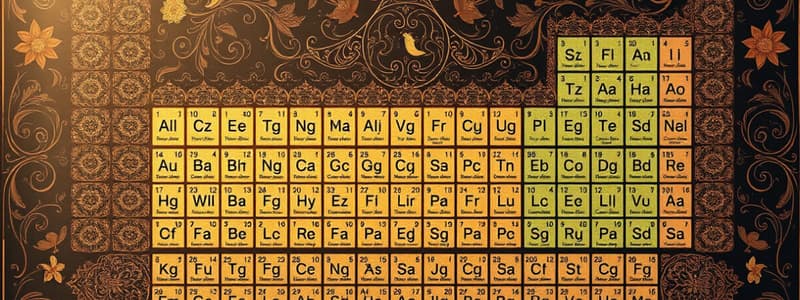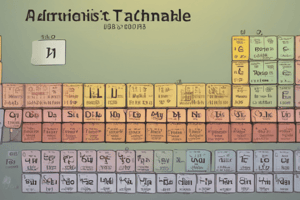Podcast
Questions and Answers
What are valence electrons?
What are valence electrons?
Outer shell electrons that determine reactivity
Which of the following characteristics describe metals?
Which of the following characteristics describe metals?
- Good conductors (correct)
- Dull and brittle
- Shiny and malleable (correct)
- Mostly gases
What are metalloids?
What are metalloids?
Elements with properties of both metals and nonmetals; semi-conductors
What are the characteristics of non-metals?
What are the characteristics of non-metals?
What does A# stand for in atomic structure?
What does A# stand for in atomic structure?
What is M in the formula M - A# = N?
What is M in the formula M - A# = N?
What is a group in the periodic table?
What is a group in the periodic table?
What is a period in the periodic table?
What is a period in the periodic table?
What type of elements are least reactive?
What type of elements are least reactive?
What type of elements are most reactive?
What type of elements are most reactive?
What does P represent in atomic structure?
What does P represent in atomic structure?
What does N represent in atomic structure?
What does N represent in atomic structure?
What does E represent in atomic structure?
What does E represent in atomic structure?
What does a period represent in terms of energy?
What does a period represent in terms of energy?
What are metalloids generally characterized by?
What are metalloids generally characterized by?
What are noble gases known for?
What are noble gases known for?
What are halogens commonly associated with?
What are halogens commonly associated with?
Flashcards are hidden until you start studying
Study Notes
Valence Electrons
- Determine chemical reactivity of an element.
- Located in the outermost shell of an atom.
Metals
- Positioned on the left side of the periodic table.
- Characterized by excellent conductivity of heat and electricity.
- Typically shiny, malleable (can be shaped), and ductile (can be stretched).
Metalloids
- Found along the staircase line on the periodic table.
- Exhibit properties of both metals and non-metals.
- Function as semi-conductors, useful in electronics.
Non-Metals
- Generally poor conductors of heat and electricity.
- Good insulators, often dull in appearance and brittle.
- Mostly exist as gases at room temperature.
Atomic Number (A#)
- Indicates the number of protons (P) in an atom.
- Also equals the number of electrons (E) in a neutral atom.
Mass Number (M- A# N)
- Represents the total number of protons and neutrons in an atom's nucleus.
Group
- Vertical columns on the periodic table, containing elements with similar properties.
- Elements in the same group typically have the same number of valence electrons.
Period
- Horizontal rows on the periodic table.
- Represents the number of energy levels or electron shells in an atom.
Least Reactive Elements
- Found in Group 18 (noble gases), characterized by having a complete outer electron shell.
Most Reactive Elements
- Found in Group 1 (alkali metals) and Group 17 (halogens).
- Tend to readily engage in chemical reactions due to their electron configurations.
Positive Charge (P)
- Refers to protons located in the atomic nucleus.
- Responsible for the positive charge of the nucleus.
Neutral Charge (N)
- Describes neutrons found in the atomic nucleus.
- Contribute to the mass of the atom but have no charge.
Negative Charge (E)
- Refers to electrons that orbit around the nucleus.
- Balance the positive charge of protons in a neutral atom.
Period Represents Energy Levels
- Indicates how many electron shells an atom has.
- An increase in period number signifies a greater number of energy levels.
Metalloids
- Elements with intermediate properties between metals and non-metals.
- Important in the development of materials and technology due to their unique characteristics.
Noble Gases
- Group 18 elements, known for their lack of reactivity due to filled electron shells.
- Includes helium, neon, argon, krypton, xenon, and radon.
Halogens (Salts)
- Group 17 elements, known for their tendency to form salts when combined with metals.
- Highly reactive, especially with alkali metals, to form ionic compounds.
Studying That Suits You
Use AI to generate personalized quizzes and flashcards to suit your learning preferences.




